| Author |
Message |
Jean Thibodeau

|
 Posted: Thu 23 Sep, 2010 10:45 am Post subject: Posted: Thu 23 Sep, 2010 10:45 am Post subject: |
 |
|
| Jeremy V. Krause wrote: | Though this axe may be hand-forged it seems to lack the historical socket shape and dimensions, not to mention forging technique, discussed in this thread.
We need to see more strictly historically designs, at least I do. 
I long to own a well executed and more historically correct Danish or early medieval axe. It is great to read that folks like Peter seem to be investing some time in the research needed in this area. |
I would look at Michael Pikula here since he makes everything ( or almost as far as I know ) by forging his blades and with his experience making swords, knives and spears with forged spear sockets getting an axe made by him put together and forged structurally like a period axe should be very doable as he could certainly research the techniques or do the work according to your research.
A & A already makes some interesting axes and with a custom project making a low carbon steel main axe body with a hardened high carbon edge would be maybe another option to look at.
Eric McHugh also made some very nice Viking or Danish axes and I have one from him that I got from Patrick Kelly from a market place sale here on " myArmoury ".
You can easily give up your freedom. You have to fight hard to get it back!
|
|
  |
 |
R D Moore

|
 Posted: Thu 23 Sep, 2010 11:29 am Post subject: Posted: Thu 23 Sep, 2010 11:29 am Post subject: |
 |
|
Jeff Pringle posted these photos of welded eye sockets in a Swedish museum on another forum. In the photos we can see the weld lines at the eye. The axes are of axes from about the 10thc. Jeff is a fellow forumite and an accomplished historical smith. I appologize for this short response but I'm at work and need to run.
 Attachment: 40.99 KB Attachment: 40.99 KB
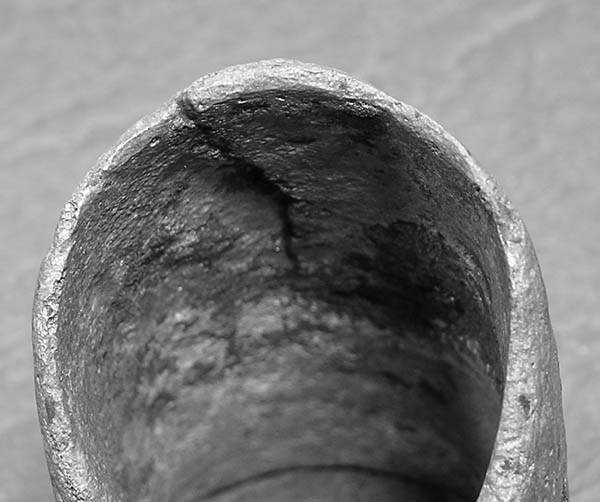
 Attachment: 75.91 KB Attachment: 75.91 KB
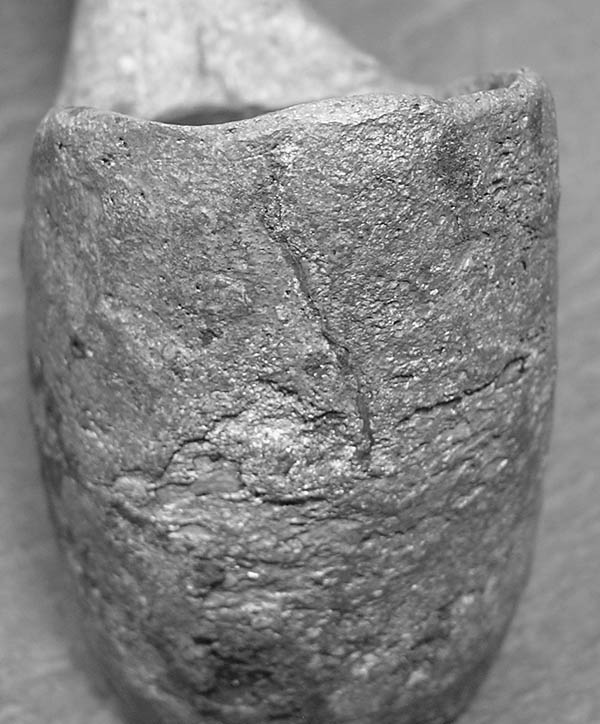
 Attachment: 50.92 KB Attachment: 50.92 KB
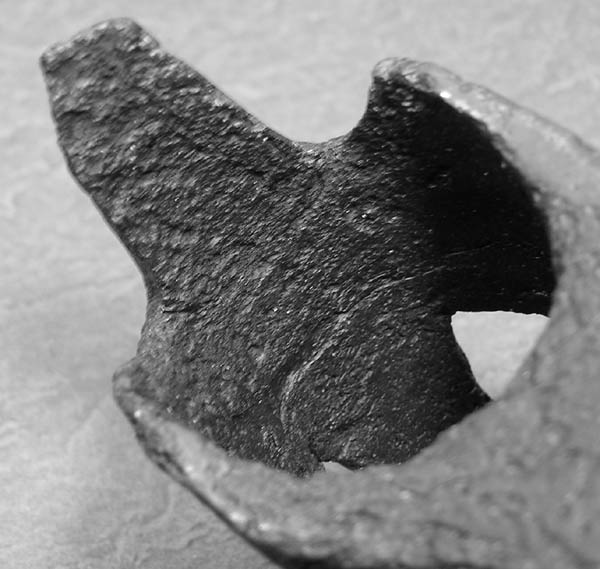
"No man is entitled to the blessings of freedom unless he be vigilant in its preservation" ...Gen. Douglas Macarthur
|
|
   |
 |
|
Ted Bouck
Location: Northe East Ohio Joined: 04 Jul 2007
Posts: 20
|
 Posted: Fri 24 Sep, 2010 9:58 am Post subject: Posted: Fri 24 Sep, 2010 9:58 am Post subject: |
 |
|
Great thread. I love Dane Axes, especially Type L's.
A friend and I made 2 Dane axes using the eye rolled around and forge welded to the main body technique in early 2009. They came out pretty good, we used 1018 steel for all, no welded on carbon edge as these were made for Norse Long hall ceremonial stuff only.
The next attemp, not sure when, will be more period with the caron edge attached along with adding ion all this info being presented.
If I might ask, what is the other forum where the pics from JP were found? I would like to read the text that went with.
Thx, Ted
|
|
   |
 |
|
Jeff Pringle
Industry Professional
Location: Oakland, CA Joined: 19 Nov 2005
Posts: 145
|
 Posted: Sun 26 Sep, 2010 9:30 am Post subject: Posted: Sun 26 Sep, 2010 9:30 am Post subject: |
 |
|
The photos come from a thread in the History section of Don Fogg’s forum, where I was saying how nice it is when you can see evidence of how things were done on the surface of artifacts. There has not been much scientific investigation of axe construction as compared to swords, but a couple archaeologists have looked into it. Dane axes would be constructed the same as other axes of the period, the broader blade would not require a totally different technique.
Here is an illustration from Radomir Peiner’s “Staré evropské kovářství” (Praha 1962), showing some different (but not all the!) ways axes were put together, the caption mentions place and age, the higher carbon material is shaded dark. These axes had their top surfaces polished and etched to show the structure.
Fig. 22. Production seams on axes according to the upper surface.
1 - Belgium, 6 to 7 Century,
2 - Morley-Meuse 4th Century (center lap steel),
3 - Lezéville, hr. 200, beginning 6th century,
4 - Novgorod, 11 century. (Welded edge),
5 - Kent, 6 to 8 century. (Welded edge).
White: iron; spotted: steel. 1-3 after Salin, 4 after Kolcin, 5 after Antein.
One small correction, the pictured axes above are in a private collection, not a museum; one of the other axes pictured in that thread on Fogg’s forum was from the Swedish Historical Museum.
 Attachment: 38.7 KB Attachment: 38.7 KB
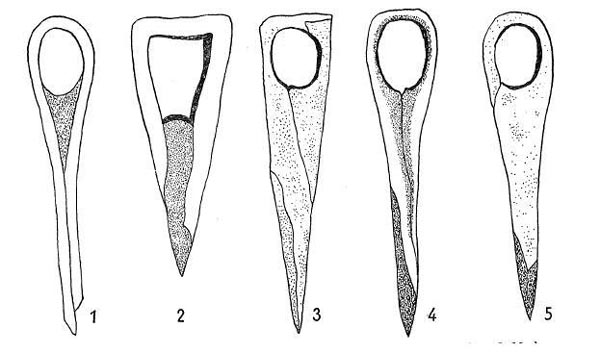
|
|
  |
 |
Luka Borscak

|
 Posted: Sun 30 Oct, 2011 2:42 pm Post subject: Posted: Sun 30 Oct, 2011 2:42 pm Post subject: |
 |
|
|
A year after I started this thread and after many delays, my axe is finally being made. I'm looking forward to it because it will be very historically accurate, 3 piece construction, iron plus steel edge, correct shape and everything. Unless something goes wrong and I hope it won't.
|
|
  |
 |
David Huggins

|
 Posted: Mon 31 Oct, 2011 1:43 am Post subject: Dane axes Posted: Mon 31 Oct, 2011 1:43 am Post subject: Dane axes |
 |
|
I own a nice Dane axe made by Ivor Lawton many years ago, forged with v section steel edge and with the head tanged at the hafting area, it is extremely light. but unfortunately I have never measured, weighted it or photographed it....which I must do as I am likely to sell it on to provide funds for a new project (hint hint  ) Although polished the forging process is pretty apparent in the surface where folds occur. ) Although polished the forging process is pretty apparent in the surface where folds occur.
best
Dave
and he who stands and sheds blood with us, shall be as a brother.
|
|
   |
 |
Luka Borscak

|
 Posted: Mon 31 Oct, 2011 2:40 am Post subject: Posted: Mon 31 Oct, 2011 2:40 am Post subject: |
 |
|
I'm sure many of us would like to both see the pictures and hear its price. 
Btw, my axe is inspired by this one (left side, middle one), picture found somewhere here, I think, but possibly on some other forum...
 Attachment: 81.11 KB Attachment: 81.11 KB
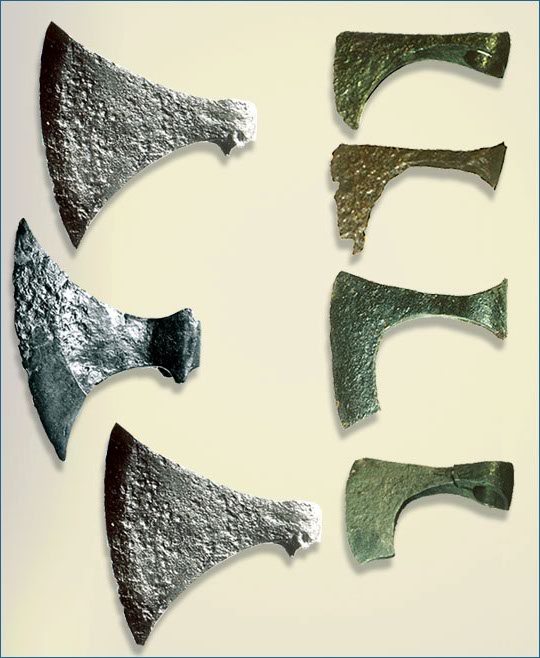
|
|
  |
 |
David Huggins

|
 Posted: Mon 31 Oct, 2011 4:39 am Post subject: Viking axe Posted: Mon 31 Oct, 2011 4:39 am Post subject: Viking axe |
 |
|
Unlike your own planned one Luka, mine is more alike to the bottom left, but with a very narrow profile, hence its lightness I guess. Mine is a semi-sharp but unlike most re-enactment ones I've handled which I think have been a bit heavy due to their very nature of use, it is possible to swing this with one hand but I expect in 'use' the two handed method would be the more devestating. The blade edge could be readily sharpened.
best
Dave
ps it would be rude of me to put the asking price but if you wish pm me... and I let you know!
and he who stands and sheds blood with us, shall be as a brother.
|
|
   |
 |
David Huggins

|
 Posted: Thu 10 Nov, 2011 6:51 am Post subject: Dane axes Posted: Thu 10 Nov, 2011 6:51 am Post subject: Dane axes |
 |
|
Thanks to friends Bruce and Paul for their camera skills I an now post some pictures of the axe that I referred to. Made by Ivor Lawton in about 1993 and now requiring a little bit of care. The ash haft is 1 metre is length, cutting edge is 20 cm, from forward tip to the top of the socket is 23cm.
 Attachment: 97.34 KB Attachment: 97.34 KB
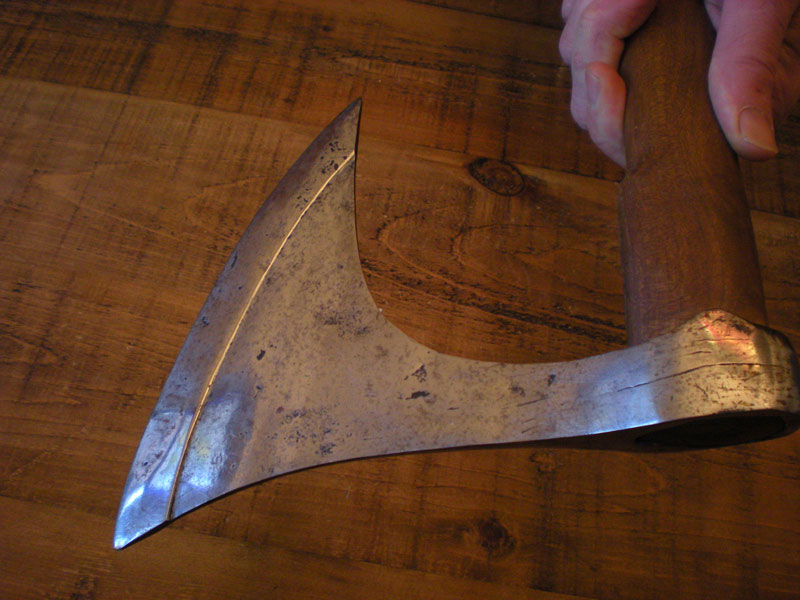
 Attachment: 91.52 KB Attachment: 91.52 KB
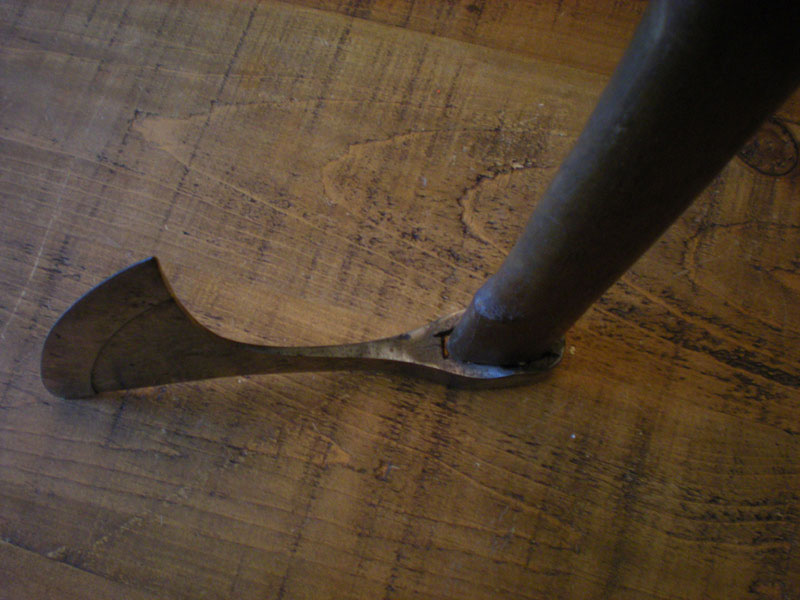
 Attachment: 80.98 KB Attachment: 80.98 KB
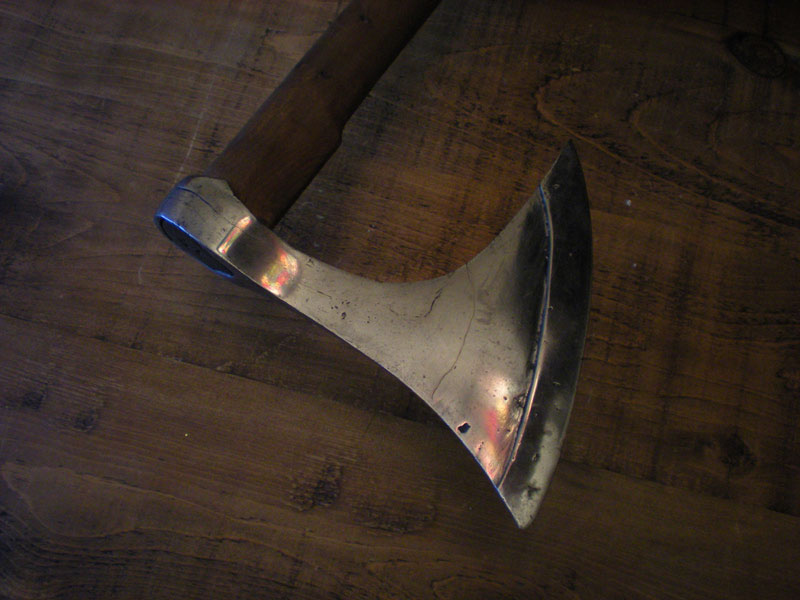
 Attachment: 84.81 KB Attachment: 84.81 KB
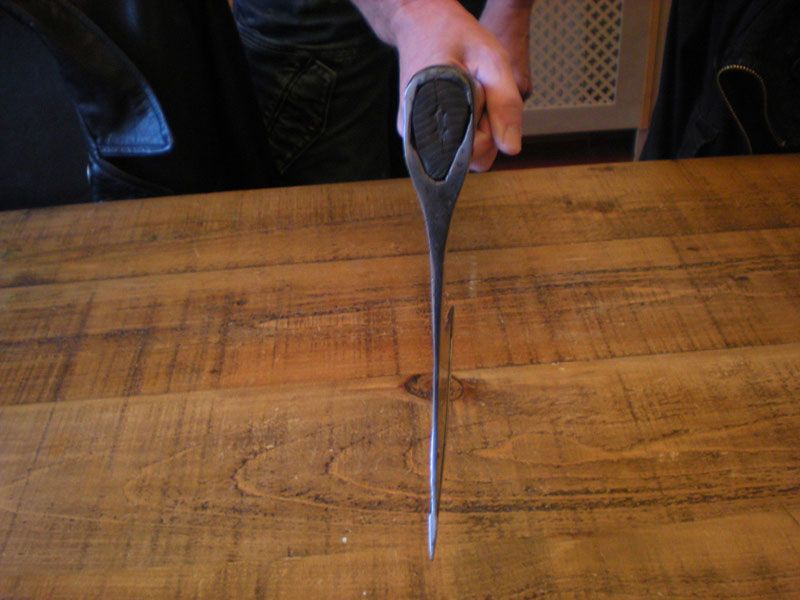
 Attachment: 88.94 KB Attachment: 88.94 KB
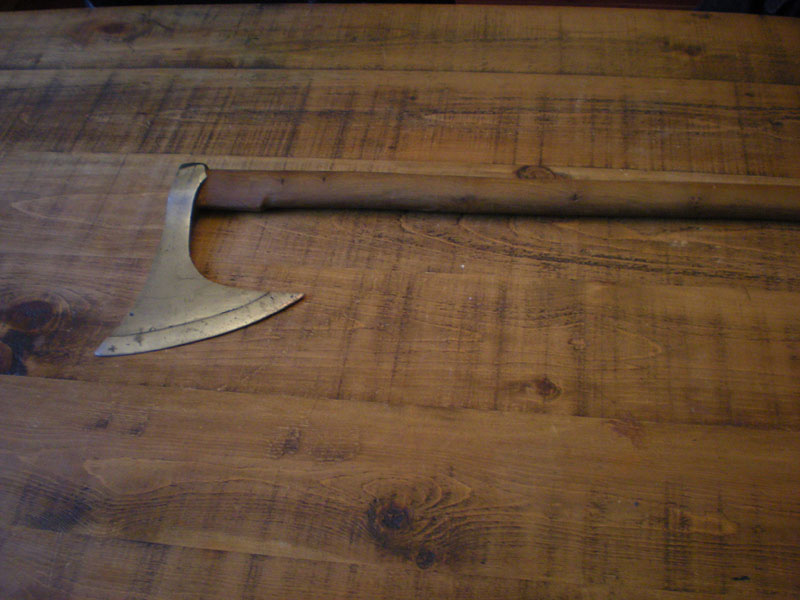
 Attachment: 90.42 KB Attachment: 90.42 KB
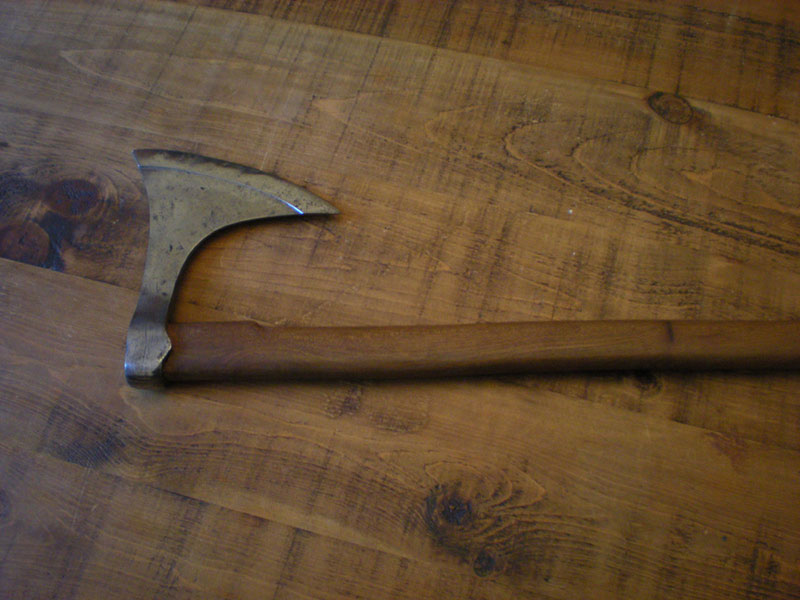
and he who stands and sheds blood with us, shall be as a brother.
|
|
   |
 |
Phil U

Location: Seattle Joined: 07 Nov 2010
Posts: 44
|
 Posted: Thu 10 Nov, 2011 7:13 am Post subject: Posted: Thu 10 Nov, 2011 7:13 am Post subject: |
 |
|
|
Wow, menacing. Also looks like it would be agile in the hand
|
|
  |
 |
Elling Polden

|
 Posted: Thu 10 Nov, 2011 8:07 am Post subject: Posted: Thu 10 Nov, 2011 8:07 am Post subject: |
 |
|
Nice looking axe.
The beard is a bit pronounced for a scadinavian broad axe, but defenitely a nice weapon.
"this [fight] looks curious, almost like a game. See, they are looking around them before they fall, to find a dry spot to fall on, or they are falling on their shields. Can you see blood on their cloths and weapons? No. This must be trickery."
-Reidar Sendeman, from King Sverre's Saga, 1201
|
|
    |
 |
|
William P
|
 Posted: Sun 13 Nov, 2011 8:50 pm Post subject: Posted: Sun 13 Nov, 2011 8:50 pm Post subject: |
 |
|
heres a few other types of axe,
the first is a rus style axe thought to likely be wielded by the varangians in service of the byzantines. from the world museum of man website. http://www.worldmuseumofman.org/display.php?item=5
it doesnt say how heavy it is, but conpared to the size of the manning imperial axehead, which is 640 grams, i imagine that this would weigh i reckon about 5-600 grams. if not alot less.
the secondis from manning imperial http://www.manningimperial.com/item.php?item_...mp;c_id=13
alot of craigs items are made blunted with the reenactor in mind, this axe is no exception it weighs about 640 grams, and the edge is about 3-4mm thick , since i havent measured the thickness.
i am in the process of buying a already hafted axewhich has this head, overall it weighs 1.7kg with a 130cm long shaft thats flared slightly at the bottom and is around 4- 6cm in diameter, to me it reminds me of a woodchopping axe handle rather than a light, murderous danish axe it can be swung one handed without too much discomfort with your hand halfway up the shaft
with a thinner shaft it would weigh a bit less.
personally im in favour of the type of axe that has a much more pronounced horn, which favours the thrust more than the bearded style.
dave huggins, how much does your axe weigh overall? and id be curious to know the head weight if you can remember it.
 Attachment: 36.25 KB Attachment: 36.25 KB
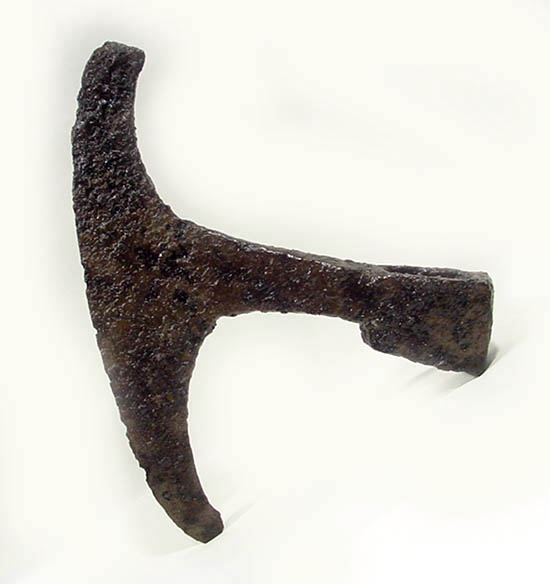
11th-12th century russian axehead 19.7 cm x 24.8 cm
 Attachment: 16.33 KB Attachment: 16.33 KB
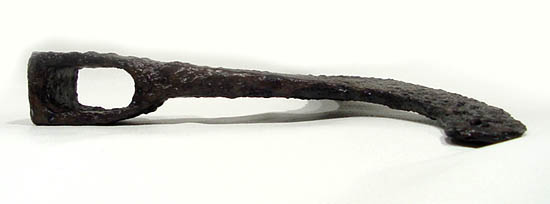
top view of russian axe
 Attachment: 50.16 KB Attachment: 50.16 KB
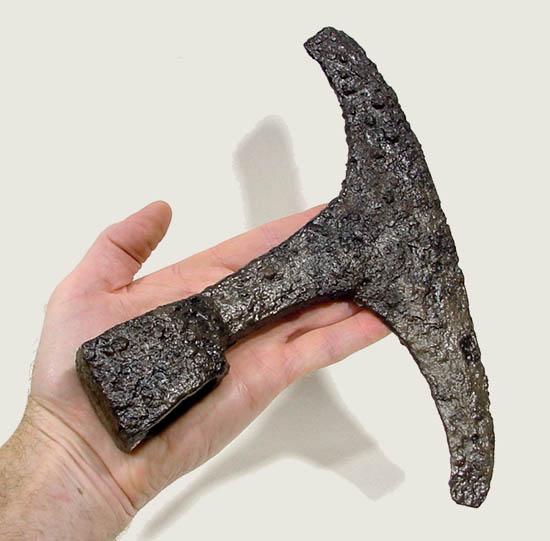
11th - 12th C russian axehead compared to hand,
19.7 cm x 24.8 cm
 Attachment: 51.24 KB Attachment: 51.24 KB
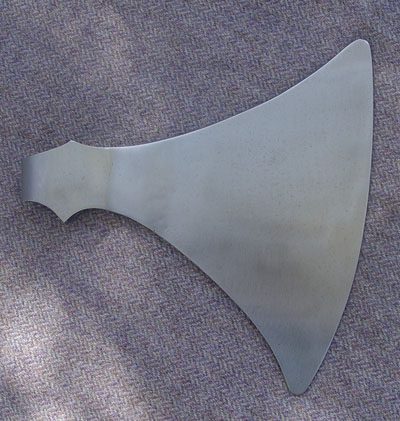
reenactment quality danish axehead from manning imperial
cutting edge approx. 25cm long approximate weight 640 grams
|
|
   |
 |
|
Ken Speed
|
 Posted: Mon 14 Nov, 2011 11:56 am Post subject: Posted: Mon 14 Nov, 2011 11:56 am Post subject: |
 |
|
William that Rus axe may be everything the museum says it is but I"m pretty sure it is also a broad axe. If you visit the Gransfor Bruks website and look at their replica axes you will see a broad axe that is remarkably similar to the one from the museum. The tip off is the off set eye which makes it easier to flatten the side of a log.
It may very well be a a Rus artifact and it may very well have been in the possession or used by a member of the Varangian guard but it still looks a whole lot like a broad axe.
|
|
  |
 |
|
William P
|
 Posted: Tue 15 Nov, 2011 5:29 am Post subject: Posted: Tue 15 Nov, 2011 5:29 am Post subject: |
 |
|
| Ken Speed wrote: | William that Rus axe may be everything the museum says it is but I"m pretty sure it is also a broad axe. If you visit the Gransfor Bruks website and look at their replica axes you will see a broad axe that is remarkably similar to the one from the museum. The tip off is the off set eye which makes it easier to flatten the side of a log.
It may very well be a a Rus artifact and it may very well have been in the possession or used by a member of the Varangian guard but it still looks a whole lot like a broad axe. |
broadaxe? what do you man, that its not a war axe but a woodworking axe??
|
|
   |
 |
Luka Borscak

|
 Posted: Tue 15 Nov, 2011 12:27 pm Post subject: Posted: Tue 15 Nov, 2011 12:27 pm Post subject: |
 |
|
|
A curve that doesn't look like unintentional damage, but rather a curve intentionally forged in the blade may point to that conclusion.
|
|
  |
 |
J Helmes
Industry Professional

Location: Lanark Highlands Ontario Canada Joined: 06 Mar 2009
Posts: 120
|
 Posted: Tue 15 Nov, 2011 5:20 pm Post subject: Posted: Tue 15 Nov, 2011 5:20 pm Post subject: |
 |
|
I believe that the Russian axe is for wood working. The offset head with slight bend allows a person to swing the blade to just one side of the body and act like a chisel . This is just speculation but I would assume that a light axe like that would be used primarily for shaping boards or a similar task, as opposed to the heavier broad axes which are used for squaring timbers.
Regardless of it's intended purpose , thanks for sharing the picture. I love axes of all kinds and this is a nicely made example. You can even make out where the edge was welded to the neck in this one.
Thanks.
Jeff
|
|
   |
 |
|
Ken Speed
|
 Posted: Tue 15 Nov, 2011 5:35 pm Post subject: Posted: Tue 15 Nov, 2011 5:35 pm Post subject: |
 |
|
William asked, ".......... what do you man, that its not a war axe but a woodworking axe??"
Ummmmm... Yes, I think it was made as a woodworking tool. It may very well be as old as the museum says it is and it may in fact have been used as a weapon sometime but I think it was intended to flatten the faces of logs.
First there is the obvious offset of the eye and by extension the axe handle. Broadaxes were/are made that way so that there is clearance between the handle and the hand of the user and the log being hewn. Then there is the long blade which made it easier to flatten a face on a wider log. lastly is the narrowness of the blade which made the axe lighter and easier to use.
I have to admit that the only war axes I know of that had an offset eye were francisca and this is certainly not one of them.
Broadaxes have relatively short hafts ( 24" to 30" long more or less) and are swung horizontally down the length of a log following a chalk line and sort of popping off pre-notched chunks from the face of the log. Then the second fave is flattened and squared to the first until you have a timber or a plank.
Looked at from a different perspective, if the museum's axe had been intended to be a weapon wouldn't it be more likely that that the blade ends would be pointed?
Compare the museum's axe head with the head of the replica hewing axe article no. 509 on the Granfors Bruks website and tell me your opinion.
|
|
  |
 |
Elling Polden

|
 Posted: Wed 16 Nov, 2011 6:31 am Post subject: Posted: Wed 16 Nov, 2011 6:31 am Post subject: |
 |
|
In the sagas, the word "broad axe" is used to describe the wide, long edged, thin profile, axes we would call daneaxes. Their counterpart where wedge axes, which have a narrow, short edged wedge profile.
The leidang laws spesificaly forbid the use of felling axes, but equates a broad axe with a sword.
"this [fight] looks curious, almost like a game. See, they are looking around them before they fall, to find a dry spot to fall on, or they are falling on their shields. Can you see blood on their cloths and weapons? No. This must be trickery."
-Reidar Sendeman, from King Sverre's Saga, 1201
|
|
    |
 |
Bartek Strojek

|
|
  |
 |
|
William P
|
 Posted: Thu 17 Nov, 2011 11:10 pm Post subject: Posted: Thu 17 Nov, 2011 11:10 pm Post subject: |
 |
|
and what consensus do we have on the haft lengths of 2 handed axes, previopusly i thought the danish longaxe reached head hieght.
but ive been getting more an more info that the danish axe was at the most only 4 feet long,
whats the consnsus among you guys? on the haft length of danish 2 handed axes?
|
|
   |
 |
|
|

